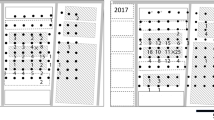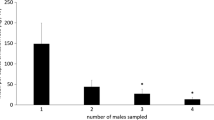Abstract
Results were analyzed from six previous studies in which marked bark and ambrosia beetles, Ips typographus, I. paraconfusus, and Trypodendron lineatum (Coleoptera: Scolytidae), were released at the center of concentric rings of pheromone traps. Assuming nearly straight flight paths, a “filtering” equation model predicts recapture percentages on several trap rings of specified radii, trap numbers, and effective attraction radius (EAR) of a pheromone trap. Equations were used to calculate recapture percentages on concentric trap rings as a function of increasing EAR and gave polynomial relationships for each ring with terms equal to the number of inner rings plus one. Results were confirmed by computer simulations. Filtering equations were iterated with increasing EAR values to find one that gave a recapture percentage for the innermost trap ring that matched the field results. The estimated EAR for a synthetic pheromone bait of I. typographus was similar in five tests (range 1.39–1.78 m), but in two other tests was larger (3.27 and 15.9 m). The EAR for pheromone of 75 male I. paraconfusus in ponderosa pine logs ranged from 0.35 to 34.5 m (mean of 4.7 m) and was generally larger for previously pheromone-responding beetles than for freshly emerged ones. For T. lineatum, the EAR of lineatin-baited traps at 100-m radius was 2.43 m. Recaptures of I. typographus were reasonably predicted by the estimated EARs in the filtering model. To obtain perfect fits, another model assumed the EAR could vary with ring radius (dispersal distance) and found that the EAR for I. typographus decreased with dispersal distance in four experiments, but increased or was variable in two others. However, in I. paraconfusus and T. lineatum, the EAR increased with dispersal distance. Simulations that varied combinations of the EAR and random angles of maximum turning (AMT) of beetles stepwise showed that a nearly straight flight path for I. typographus explained observed catches on trap rings best, while a higher AMT of 36° was better to explain catches of T. lineatum. Simulations show that catch per trap ring in relation to radial distance can be influenced by the beetle's AMT (still unobserved in the field). A conceptual model of dispersal and host selection in “aggressive” bark beetles with regard to pioneer and joiner colonization strategies is presented.
Similar content being viewed by others
REFERENCES
Anderbrant, O., Schlyter, F., and Birgersson, G. 1985. Intraspecific competition affecting parents and offspring in the bark beetle Ips typographus. Oikos 45:89–98.
Atkins, M. D. 1960. A study of the flight of the Douglas-fir beetle Dendroctonus pseudotsugae Hopk. (Coleoptera: Scolytidae) II. Flight Movements. Can. Entomol. 92:941–954.
Atkins, M. D. 1961. A study of the flight of the Douglas-fir beetle Dendroctonus pseudotsugae Hopk. (Coleoptera: Scolytidae) III. Flight capacity. Can. Entomol. 93:467–474.
Atkins, M. D. 1966. Laboratory studies on the behavior of the Douglas-fir beetle, Dendroctonus pseudotsugae Hopkins. Can. Entomol. 98:953–991.
Atkins, M. D. 1969. Lipid loss with flight in the Douglas-fir beetle. Can. Entomol. 101:164–165.
Atkins, M. D. 1975. On factors affecting the size, fat content and behavior of a scolytid. Z. Angew. Entomol. 78:209–218.
Bennett, R. B., and Borden, J. H. 1971. Flight arrestment of tethered Dendroctonus pseudotsugae and Trypodendron lineatum (Coleoptera: Scolytidae) in response to olfactory stimuli. Ann. Entomol. Soc. Am. 64:1273–1286.
Berryman, A. A., and Ashraf, M. 1970. Effects of Abies grandis resin on the attack behavior and brood survival of Scolytus ventralis (Coleoptera: Scolytidae). Can. Entomol. 102:1229–1236.
Borden, J. H., Hunt, D. W. A., Miller, D. R., and Slessor, K. N. 1986. Orientation in forest Coleoptera: An uncertain outcome of responses by individual beetles to variable stimuli, pp. 97–109, in T. L. Payne, M. C. Birch, and C. E. J. Kennedy (eds.). Mechanisms in Insect Olfaction. Clarendon Press, Oxford.
Borden, J. H., Chong, L. J., Savoie, A., and Wilson, I. M. 1997. Responses to green leaf volatiles in two biogeoclimatic zones by striped ambrosia beetle, Trypodendron lineatum. J. Chem. Ecol. 23:2479–2491.
Botterweg, P. F. 1982. Dispersal and flight behaviour of the spruce bark beetle Ips typographus in relation to sex, size and fat content. Z. Angew. Entomol. 94:466–489.
Byers, J. A. 1991. Simulation of mate-finding behaviour of pine shoot beetles, Tomicus piniperda. Anim. Behav. 41:649–660.
Byers, J. A. 1993a. Simulation and equation models of insect population control by pheromone-baited traps. J. Chem. Ecol. 19:1939–1956.
Byers, J. A. 1993b. Orientation of bark beetles Pityogenes chalcographus and Ips typographus to pheromone-baited puddle traps placed in grids: A new trap for control of scolytids. J. Chem. Ecol. 19:2297–2316.
Byers, J. A. 1995. Host tree chemistry affecting colonization in bark beetles, pp. 154–213, in R. T. Cardé and W. J. Bell (eds.). Chemical Ecology of Insects 2. Chapman and Hall, New York.
Byers, J. A. 1996a. An encounter rate model for bark beetle populations searching at random for susceptible host trees. Ecol. Model. 91:57–66.
Byers, J. A. 1996b. Temporal clumping of bark beetle arrival at pheromone traps: Modeling anemotaxis in chaotic plumes. J. Chem. Ecol. 22:2133–2155.
Byers, J. A., Anderbrant, O., and LÖfqvist, J. 1989. Effective attraction radius: A method for comparing species attractants and determining densities of flying insects. J. Chem. Ecol. 15:749–765.
Byers, J. A., Zhang, Q. H., Schlyter, F., and Birgersson, G. 1998. Volatiles from nonhost birch trees inhibit pheromone response in spruce bark beetles. Naturwissenschaften 85:557–561.
Choudhury, J. H., and Kennedy, J. S. 1980. Light versus pheromone-bearing wind in the control of flight direction by bark beetles, Scolytus multistriatus. Physiol. Entomol. 5:207–214.
Duelli, P., Zahradnik, P., Knizek, M., and Kalinova, B. 1997. Migration in spruce bark beetles (Ips typographus L.) and the efficiency of pheromone traps. J. Appl. Entomol. 121:297–303.
Forsse, E. 1991. Flight propensity and diapause incidence in five populations of the bark beetle Ips typographus in Scandinavia. Entomol. Exp. Appl. 61:53–57.
Forsse, E., and Solbreck, C. 1985. Migration in the bark beetle Ips typographus L.: Duration, timing and height of flight. Z. Angew. Entomol. 100:47–57.
Gara, R. I. 1963. Studies on the flight behavior of Ips confusus (LeC.) (Coleoptera: Scolytidae) in response to attractive material. Contrib. Boyce Thompson Inst. 22:51–66.
Graham, K. 1959. Release by flight exercise of a chemotropic response from photopositive domination in a scolytid beetle. Nature 184:282–284.
Gries, G., Nolte, R., and Sanders, W. 1989. Computer simulated host selection in Ips typographus. Entomol. Exp. Appl. 53:211–217.
Gries, G., Bowers, W. W., Gries, R., Noble, M., and Borden, J. H. 1990. Pheromone production by the pine engraver Ips pini following flight and starvation. J. Insect Physiol. 36:819–824.
Hagen, B. W., and Atkins, M. D. 1975. Between generation variability in the fat content and behaviour of Ips paraconfusus Lanier. Z. Angew. Entomol. 79:169–172.
Hynum, B. G., and Berryman, A. A. 1980. Dendroctonus ponderosae (Coleoptera: Scolytidae) pre-aggregation landing and gallery initiation on lodgepole pine. Can. Entomol. 112:185–192.
Jactel, H., and Gaillard, J. 1991. A preliminary study of the dispersal potential of Ips sexdentatus Boern (Coleoptera: Scolytidae) with an automatically recording flight mill. J. Appl. Entomol. 112:138–145.
LindelÖw, Å., and Weslien, J. 1986. Sex-specific emergence of Ips typographus L. (Coleoptera: Scolytidae) and flight behaviour in response to pheromone sources following hibernation. Can. Entomol. 118:59–67.
Miller, J. M., and Keen, F. P. 1960. Biology and Control of the Western Pine Beetle. USDA misc. pub. 800, 381 pp.
Moeck, H. A., Wood, D. L., and Lindahl, K. Q., Jr. 1981. Host selection behavior of bark beetles (Coleoptera: Scolytidae) attacking Pinus ponderosa, with special emphasis on the western pine beetle, Dendroctonus brevicomis. J. Chem. Ecol. 7:49–83.
Nilssen, A. C. 1978. Development of a bark fauna in plantations of spruce [Picea abies (L.) Karst.] in north Norway. Astarta 11:151–169.
Raffa, K. F., and Berryman, A. A. 1979. Flight responses and host selection by bark beetles, pp. 213–233, in A. A. Berryman and L. Safranyik (eds.). Dispersal of Forest Insects: Evaluation, Theory and Management Implications. Proceedings, Second IUFRO Conference, Canada and USDA Forest Service, Washington State University, Pullman, Washington.
Salom, S. M., and McLean, J. A. 1989. Influence of wind on the spring flight of Trypodendron lineatum (Oliver) (Coleoptera: Scolytidae) in a second-growth coniferous forest. Can. Entomol. 121:109–119.
Schlyter, F. 1992. Sampling range attraction range and effective attraction radius estimates of trap efficiency and communication distance in coleopteran pheromone and host attractant systems. J. Appl. Entomol. 114:439–454.
Schlyter, F., Birgersson, G., Byers, J. A., LÖfqvist, J., and BergstrÖm, G. 1987. Field response of spruce bark beetle, Ips typographus, to aggregation pheromone candidates. J. Chem. Ecol. 13:701–716.
Skellam, J. G. 1973. The formulation and interpretation of mathematical models of diffusionary processes in population biology, pp. 63–85, in M. S. Bartlett and R. W. Hiorns (eds.). The Mathematical Theory of the Dynamics of Biological Populations. Academic Press, London.
Thompson, S. N., and Bennett, R. B. 1971. Oxidation of fat during flight of male Douglas-fir beetles, Dendroctonus pseudotsugae. J. Insect Physiol. 17:1555–1563.
Wood, D. L. 1982. The role of pheromones, kairomones, and allomones in the host selection and colonization behavior of bark beetles. Annu. Rev. Entomol. 27:411–446.
Wood, D. L., and Bushing, R. W. 1963. The olfactory response of Ips confusus (LeConte) (Coleoptera: Scolytidae) to the secondary attraction in the laboratory. Can. Entomol. 95:1066–1078.
Zolubas, P., and Byers, J. A. 1995. Recapture of dispersing bark beetles, Ips typographus L. (Col. Scolytidae) in pheromone-baited traps: regression models. J. Appl. Entomol. 19:285–289.
Zumr, V. 1992. Dispersal of the spruce bark beetle Ips typographus (L.) (Col., Scolytidae) in spruce woods. J. Appl. Entomol. 114:348–352.
Author information
Authors and Affiliations
Rights and permissions
About this article
Cite this article
Byers, J.A. Effects of Attraction Radius and Flight Paths on Catch of Scolytid Beetles Dispersing Outward Through Rings of Pheromone Traps. J Chem Ecol 25, 985–1005 (1999). https://doi.org/10.1023/A:1020869422943
Issue Date:
DOI: https://doi.org/10.1023/A:1020869422943




